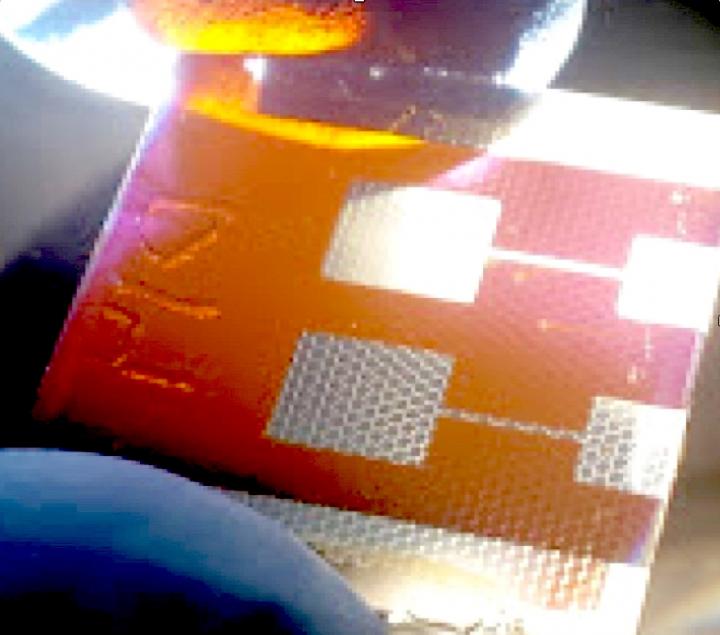Insect eyes inspire new solar cell design from Stanford

A compound solar cell illuminated from a light source below. Hexagonal scaffolds are visible in the regions coated by a silver electrode. The new solar cell design could help scientists overcome a major roadblock to the development of perovskite photovoltaics. Credit: Dauskardt Lab/Stanford University
In a new study, the Stanford team used the insect-inspired design to protect a fragile photovoltaic material called perovskite from deteriorating when exposed to heat, moisture or mechanical stress. The results are published in the journal Energy & Environmental Science (E&ES).
“Perovskites are promising, low-cost materials that convert sunlight to electricity as efficiently as conventional solar cells made of silicon,” said Reinhold Dauskardt, a professor of materials science and engineering and senior author of the study. “The problem is that perovskites are extremely unstable and mechanically fragile. They would barely survive the manufacturing process, let alone be durable long-term in the environment.”
Most solar devices, like rooftop panels, use a flat, or planar, design. But that approach doesn't work well with perovskite solar cells.
“Perovskites are the most fragile materials ever tested in the history of our lab,” said graduate student Nicholas Rolston, a co-lead author of the E&ES study. “This fragility is related to the brittle, salt-like crystal structure of perovskite, which has mechanical properties similar to table salt.”
Eye of the fly
To address the durability challenge, the Stanford team turned to nature.
“We were inspired by the compound eye of the fly, which consists of hundreds of tiny segmented eyes,” Dauskardt explained. “It has a beautiful honeycomb shape with built-in redundancy: If you lose one segment, hundreds of others will operate. Each segment is very fragile, but it's shielded by a scaffold wall around it.”
Using the compound eye as a model, the researchers created a compound solar cell consisting of a vast honeycomb of perovskite microcells, each encapsulated in a hexagon-shaped scaffold just 0.02 inches (500 microns) wide.
“The scaffold is made of an inexpensive epoxy resin widely used in the microelectronics industry,” Rolston said. “It's resilient to mechanical stresses and thus far more resistant to fracture.”
Tests conducted during the study revealed that the scaffolding had little effect on the perovskite's ability to convert light into electricity.
“We got nearly the same power-conversion efficiencies out of each little perovskite cell that we would get from a planar solar cell,” Dauskardt said. “So we achieved a huge increase in fracture resistance with no penalty for efficiency.”
Durability
But could the new device withstand the kind of heat and humidity that conventional rooftop solar panels endure?
To find out, the researchers exposed encapsulated perovskite cells to temperatures of 185 degrees Fahrenheit (85 degrees Celsius) and 85 percent relative humidity for six weeks. Despite these extreme conditions, the cells continued to generate electricity at relatively high rates of efficiency.
Dauskardt and his colleagues have filed a provisional patent for the new technology. To improve efficiency, they are studying new ways to scatter light from the scaffold into the perovskite core of each cell.
“We are very excited about these results,” he said. “It's a new way of thinking about designing solar cells. These scaffold cells also look really cool, so there are some interesting aesthetic possibilities for real-world applications.”
###
The other co-lead authors of the E&ES study are Stanford postdoctoral scholars Brian Watson and Adam Printz.
Media Contact
All latest news from the category: Materials Sciences
Materials management deals with the research, development, manufacturing and processing of raw and industrial materials. Key aspects here are biological and medical issues, which play an increasingly important role in this field.
innovations-report offers in-depth articles related to the development and application of materials and the structure and properties of new materials.
Newest articles

NASA: Mystery of life’s handedness deepens
The mystery of why life uses molecules with specific orientations has deepened with a NASA-funded discovery that RNA — a key molecule thought to have potentially held the instructions for…

What are the effects of historic lithium mining on water quality?
Study reveals low levels of common contaminants but high levels of other elements in waters associated with an abandoned lithium mine. Lithium ore and mining waste from a historic lithium…

Quantum-inspired design boosts efficiency of heat-to-electricity conversion
Rice engineers take unconventional route to improving thermophotovoltaic systems. Researchers at Rice University have found a new way to improve a key element of thermophotovoltaic (TPV) systems, which convert heat…



